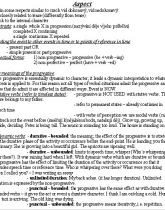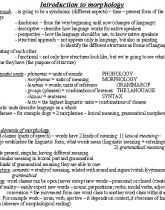Přednášky: Morfologie Anglického jazyka
Skrýt detaily | Oblíbený- Kvalita:86,0 %
- Typ:Přednášky
- Univerzita:Univerzita Jana Evangelisty Purkyně v Ústí nad Labem
- Fakulta:Pedagogická fakulta
- Kategorie:Jazyky
- Podkategorie:Angličtina
- Předmět:Anglický jazyk
- Autor:josef.trousil
- Ročník:1. ročník
- Rozsah A4:35 strán
- Zobrazeno:1 594 x
- Stažené:0 x
- Velikost:0,2 MB
- Formát a přípona:MS Office Word (.doc)
- Jazyk:český
- ID projektu:3063
- Poslední úprava:09.04.2014
Introduction to morphology
1) Approach: - is going to be a synchronic (different aspects) - time - present form of the language
- diachronic - from the very beginning until now (changes of language)
- descriptive - describe how language works for native speakers
- perspective - how the language should be use; to know native speakers
- structural approach - not appears only in language, but also in painting
- to identify the different structures as forms of language, cooperating of each other
- functional - not only how structures look like, but we´re going to see what functions they have (the purpose of structure)
2) Linguistic units:- phonemes = units of sounds PHONOLOGY
- morphemes = units of meaning MORPHOLOGY
- lexemes = words; units of reference GRAMMAR OF
- groups (phrases) = combination of lexemes THE LANGUAGE
- clauses = sentences SYNTAX
- texts = the highest linguistic units = combinations of clauses
- linguistic units describe language as a whole
- morphemes - for example dogs = 2 morphemes - lexical meaning, grammatical morphemes, s - plural
3) The elements of morphology:
a) word classes (parts of speech) - words have 2 kinds of meaning: 1) lexical meaning - language establishes the linguistic form; what words mean (linguistic meaning + extralinguistic)
2) grammatical meaning - for example present, singular, having different meaning
- have similar meaning in lexical part and grammatical
- what kinds of grammatical meaning they are able to care
- distinction: semantic = study of meaning, related with sound and signes (vztah k významu)
grammatical
- features: word classes can be open (never except new words - pronouns) or closed (create new items of reality - easily expect new words - nouns; prepositions; verbs, modal verbs, adjectives)
conversion = the movement from one word class to another word class without any change. For example work - noun, verb, ajective - it depends on context,it´s because of historical reasons (absence of morphological ending)
1) Approach: - is going to be a synchronic (different aspects) - time - present form of the language
- diachronic - from the very beginning until now (changes of language)
- descriptive - describe how language works for native speakers
- perspective - how the language should be use; to know native speakers
- structural approach - not appears only in language, but also in painting
- to identify the different structures as forms of language, cooperating of each other
- functional - not only how structures look like, but we´re going to see what functions they have (the purpose of structure)
2) Linguistic units:- phonemes = units of sounds PHONOLOGY
- morphemes = units of meaning MORPHOLOGY
- lexemes = words; units of reference GRAMMAR OF
- groups (phrases) = combination of lexemes THE LANGUAGE
- clauses = sentences SYNTAX
- texts = the highest linguistic units = combinations of clauses
- linguistic units describe language as a whole
- morphemes - for example dogs = 2 morphemes - lexical meaning, grammatical morphemes, s - plural
3) The elements of morphology:
a) word classes (parts of speech) - words have 2 kinds of meaning: 1) lexical meaning - language establishes the linguistic form; what words mean (linguistic meaning + extralinguistic)
2) grammatical meaning - for example present, singular, having different meaning
- have similar meaning in lexical part and grammatical
- what kinds of grammatical meaning they are able to care
- distinction: semantic = study of meaning, related with sound and signes (vztah k významu)
grammatical
- features: word classes can be open (never except new words - pronouns) or closed (create new items of reality - easily expect new words - nouns; prepositions; verbs, modal verbs, adjectives)
conversion = the movement from one word class to another word class without any change. For example work - noun, verb, ajective - it depends on context,it´s because of historical reasons (absence of morphological ending)


